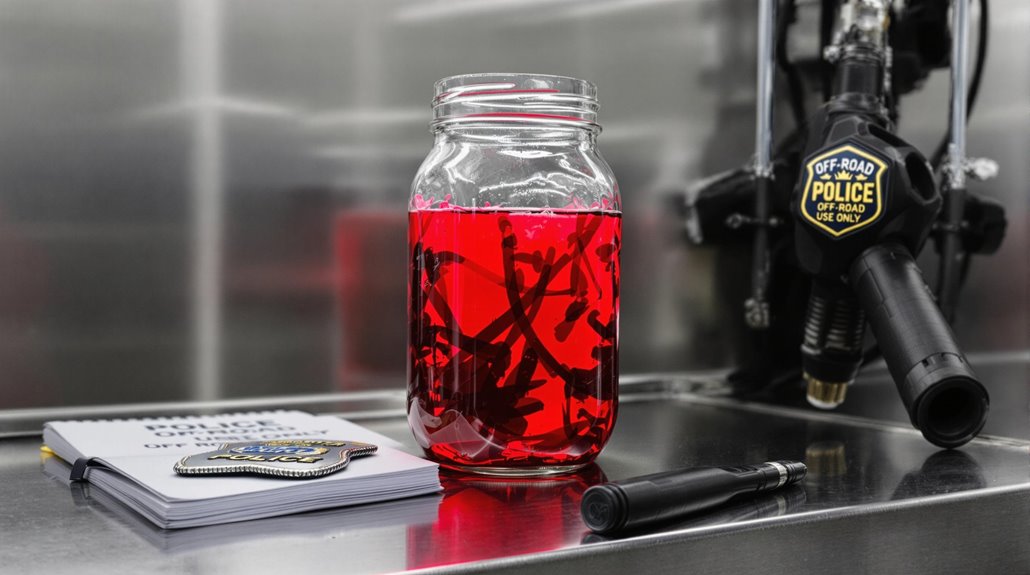Dyed diesel is a specially colored fuel that’s legal for off-road use in agriculture, construction, and marine equipment, but illegal for regular vehicles on public roads. You can identify it by its bright red or blue color, added to prevent tax evasion since it’s taxed at a lower rate than regular diesel. While the dye doesn’t affect performance, using it illegally can result in hefty fines starting at $1,000. Understanding the proper applications helps you avoid serious penalties.
Understanding Dyed Diesel: Purpose and Composition

When you first encounter dyed diesel at a fuel station, you’ll notice its distinctive red or blue coloring that sets it apart from regular diesel fuel. The dyed diesel composition is identical to regular diesel, but it contains a special soluble dye that’s added for identification purposes.
You’ll find that dyed diesel benefits specific industries and applications, primarily in agriculture, construction, and off-road vehicles. The dye helps government officials easily identify this tax-exempt fuel, which is meant exclusively for off-road use.
While the chemical makeup remains the same as regular diesel, the colored marker guarantees proper usage and prevents tax evasion. The dye doesn’t affect engine performance or fuel efficiency, so you can expect the same quality and energy output as standard diesel fuel.
Legal Uses and Applications of Dyed Diesel Fuel
Because dyed diesel fuel comes with specific legal restrictions, you’ll need to understand exactly where and how you can use it. Under current dyed diesel regulations, you’re allowed to use this fuel for specific off-road applications and certain types of equipment.
The most common legal uses for dyed diesel include:
- Agricultural machinery like tractors, harvesters, and irrigation systems
- Construction equipment such as bulldozers, excavators, and generators
- Marine vessels including boats, ships, and other watercraft
When considering dyed diesel applications, remember that it’s strictly forbidden to use this fuel in on-road vehicles.
You’ll face hefty fines if you’re caught using dyed diesel in your regular truck or car. Always check local regulations, as specific rules can vary by state and region.
Tax Implications and Price Differences
Since dyed diesel fuel isn’t taxed at the same rate as regular diesel, you’ll notice significant price differences between the two types at the pump.
The tax benefits of dyed diesel can result in savings of up to 50 cents per gallon or more, depending on your location and current market conditions.
These pricing variations exist because dyed diesel is intended for off-road use in agriculture, construction, and other specific industries.
You’ll find that farmers and construction companies can save thousands of dollars annually through these tax exemptions.
However, if you’re caught using dyed diesel in on-road vehicles, you could face steep fines and penalties that far outweigh any potential savings.
The price difference reflects the federal and state road taxes that help maintain highways and infrastructure, which off-road vehicles don’t typically use.
Penalties and Consequences of Misuse

The penalties for misusing dyed diesel can quickly erase any tax savings you might’ve hoped to gain.
If you’re caught using dyed diesel in your on-road vehicle, you’ll face serious legal consequences and misuse penalties that could impact both your finances and freedom.
The federal government and state authorities don’t take dyed diesel violations lightly, and you could face:
- Hefty fines starting at $10 per gallon or $1,000, whichever is greater
- Potential criminal charges leading to jail time, especially for repeat offenders
- Suspension of your commercial driver’s license and vehicle registration
How to Identify and Handle Dyed Diesel Properly
Properly identifying and handling dyed diesel fuel requires careful attention to key visual and physical characteristics that set it apart from regular diesel.
You’ll notice its distinct red or blue color, which makes dyed diesel identification straightforward in most cases. When handling the fuel, always wear appropriate protective gear and follow proper storage guidelines.
Here’s what to look for when identifying dyed diesel:
- Bright red or blue coloring
- Strong diesel odor
- Clear, particle-free appearance
- Official markings on storage containers
For safe dyed diesel handling:
- Use dedicated storage tanks
- Check for proper labeling
- Keep detailed records of purchases
- Store away from heat sources
- Clean spills immediately
- Maintain temperature control
- Follow local regulations for disposal
Conclusion
As the saying goes, “penny wise and pound foolish” – trying to save money by illegally using dyed diesel isn’t worth the risk. You’ll want to guarantee you’re using the right fuel for your vehicle and purpose, following all regulations to avoid hefty fines and legal trouble. Remember that dyed diesel serves important purposes in specific applications, but it’s essential to stick to its intended uses and maintain proper documentation when you’re using it.

